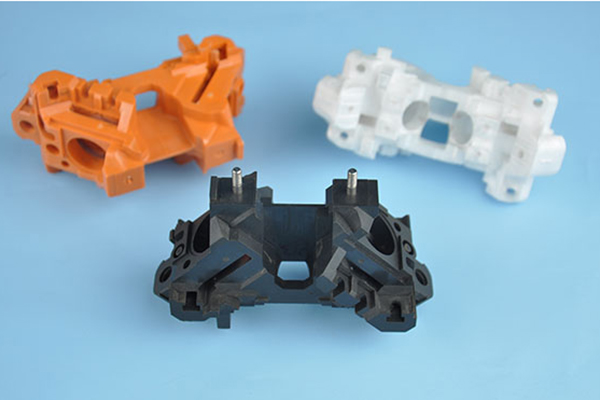Plastic Injection Molding Process Steps
Plastic injection molding is a versatile and highly efficient manufacturing process used to produce a wide range of plastic parts and products. First, an appropriate thermoplastic or thermoset material is selected, then heated and injected into a precisely designed mold cavity. The material rapidly cools and solidifies within the mold, taking on the desired shape and ultimately forming the part. This process can create complex parts with high accuracy and repeatability and is therefore widely used in various industries. This article will focus on the four main steps: clamping, injection, cooling and ejection. Fine control of these steps is key to ensuring the manufacturing of high-quality plastic parts.

Clamping Mechanism of an Injection Molding Machine
Clamping in the injection molding process involves securing each half of the mold to the injection molding machine using the clamping unit. This powered clamping unit is responsible for bringing the mold halves together and applying the necessary force to firmly hold the mold closed while the liquid resin material is injected into the mold cavities.
The duration for clamping the mold and maintaining its closure depends on the size of the molding press. Clamping force is a critical factor in determining the size of the injection molding press required for manufacturing your specific component. Once you’ve determined the press size your part necessitates, you’ll have a key parameter that your injection molder needs to manufacture your product effectively.
Injection Stage of Raw Resin Material
The injection phase entails introducing the raw material into the injection molding machine and advancing it towards the mold using the injection unit. As the material moves forward, the combination of heat and pressure causes it to melt. The injection unit then utilizes pressure buildup to transport the molten plastic into the mold cavities.
Achieving precise melt temperatures involves configuring various settings, including barrel temperature, nozzle temperature, and mold temperature. Barrel and nozzle temperatures influence the plastic’s flowability within the mold, while mold temperature affects both material flow and the subsequent cooling of the molded part. Careful consideration must be given to the barrel and nozzle temperature settings. Excessively high temperatures can lead to overflow and flash, while excessively low temperatures may result in incomplete part filling.
Plastic pressure is another crucial aspect of the injection molding process. It refers to the physical force exerted on the molten resin by the screw head as the screw advances, a function controlled by the injection molding machine’s automated system.
Temperature and pressure adjustments are fundamental when establishing a stable and efficient injection molding process.
Cooling Time in Plastic Injection Molding
Cooling is the critical phase where the molten plastic within the mold cavities undergoes solidification to assume the desired part shape. The cooling process initiates upon contact with the inner mold surfaces. The mold remains closed until the prescribed cooling duration has transpired. Recommendations for setting the injection mold temperature are typically furnished by the resin raw material manufacturer. Cooling times are influenced by the design of both the part and the mold, in addition to the specific resin raw material employed. The injection mold design often incorporates internal cooling mechanisms to expedite this phase.
Ejection of Plastic Part
Ejection occurs after the required time has passed to cool the part. When the clamping unit opens the injection mold, an ejection mechanism pushes the parts out of the mold. During the cooling process, the component shrinks and adheres to the mold cavities requiring force to eject the part. After the ejection and removal of the part or parts, the mold closes for the injection of the next shot, starting the next cycle.
Sungplastic’s Plastic Injection Molding Services
Sungplastic is an experienced plastic injection molding manufacturer specializing in providing versatile and efficient solutions for the production of various plastic parts and products. Our services cover the entire manufacturing process, from mold design to delivery of finished parts. The plastic injection molding services provided by Sungplastic include the following:
-
- Mold design: Sungplastic adopts the Design for Manufacturability (DFM) principle for mold design, taking into account manufacturing issues in the early stages of product design, thereby reducing the risk of later modifications and cost increases.
- Material Selection: Sungplastic’s professionals will assist in selecting the appropriate thermoplastic or thermoset material based on specific project requirements, including strength, durability and aesthetic considerations.
- Injection Molding: Sungplastic uses state-of-the-art injection molding machines to melt the selected plastic material and then inject it into carefully crafted molds with precise control.
- Quality Control: Sungplastic implements strict quality control processes throughout the production process to monitor and ensure parts meet strict quality standards and specifications.
- Secondary Processing: We offer additional services such as assembly, finishing and custom packaging to deliver complete finished products.
- Customization: Sungplastic’s plastic injection molding services can be tailored to meet your unique needs across industries ranging from automotive and electronics to medical and consumer products.
- On-time delivery: We will deliver the goods within the specified time to ensure that the products reach the customers on time.
Now you have an in-depth understanding of Sungplastic’s plastic injection molding services and processes, but our service scope does not stop there. For example, metal injection molding, CNC machining, surface finish, etc. are all our areas of expertise. If you have any related needs, please feel free to contact us and let us start our cooperation.
Get a free quote and design analysis today.
We’ll reply to you within 6 working hours.
We respect your privacy.
+86 139 2927 4777 (WhatsApp, Wechat)
